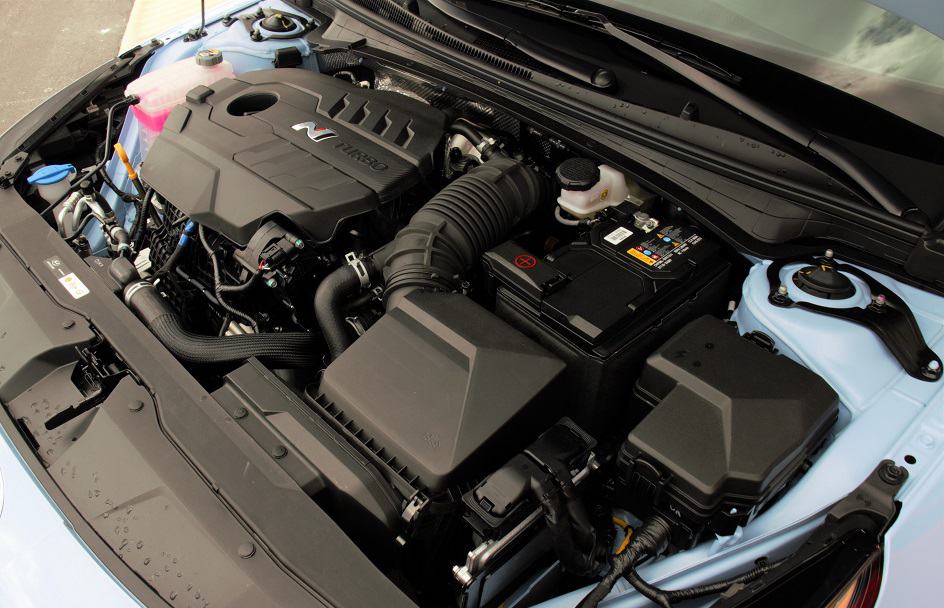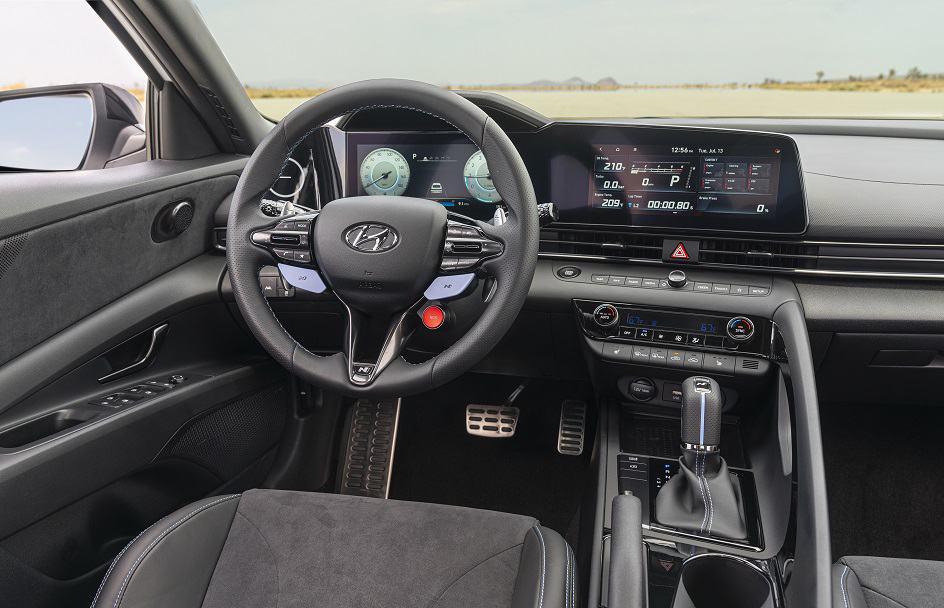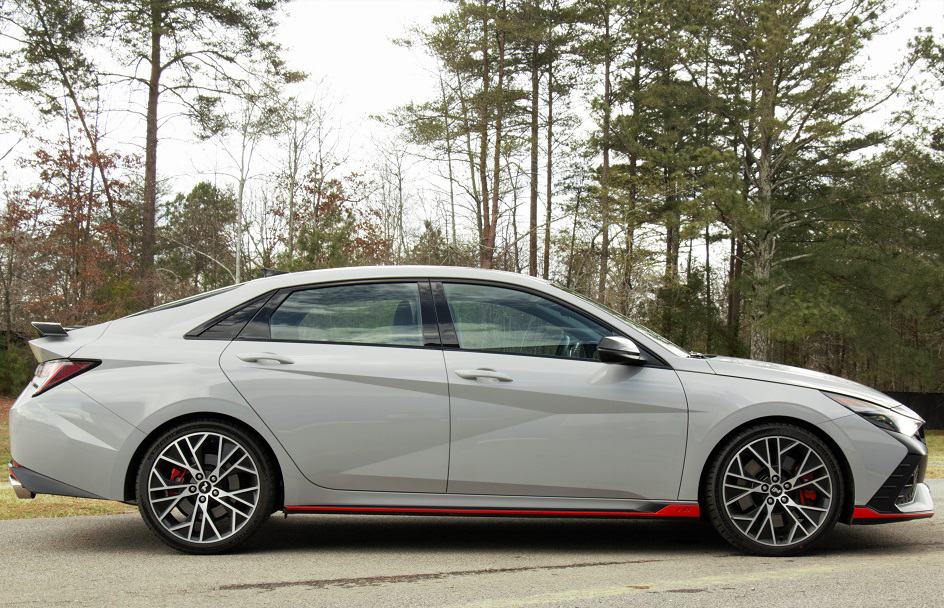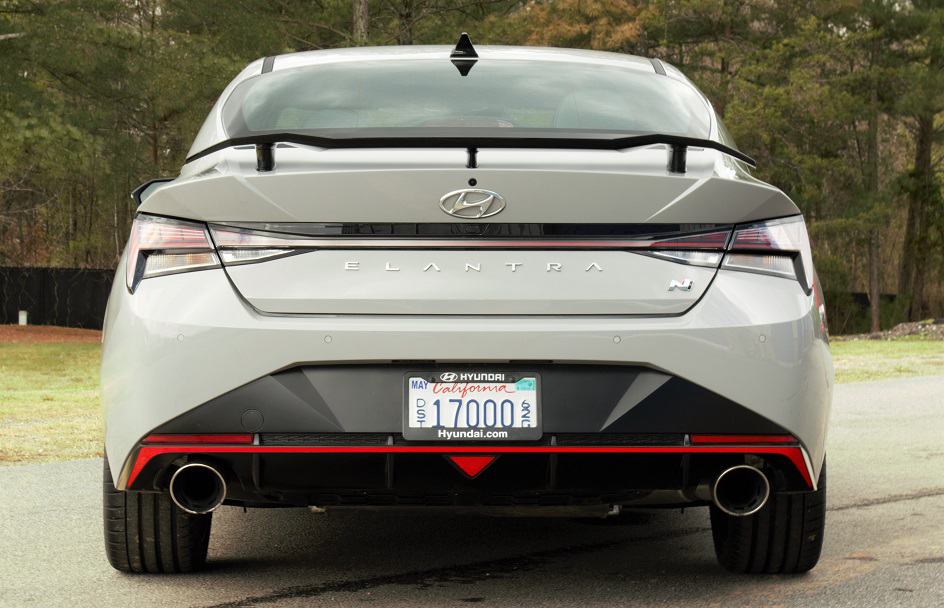(Please note: Part 1 can be read here)
Over the past several years, SUVs have benefited from staggering popularity. They’ve been a boon to the automotive industry, but detrimental to sedan sales. Ford and General Motors made headlines for deciding to kill off or substantially reduce their traditional four-door lineups. Other manufacturers, such as Hyundai, decided to stick it out in the sedan segment. The opportunities they have in that less populated space are also their obligations.
Hyundai has the freedom to create versions of its cars it’s never offered before, but it also needs to make those so that those models appeal to as many different types of buyers as possible. That explains why Hyundai introduced its first-ever Elantra Hybrid for the 2021 model year. To attract customers who prioritize high performance over hypermiling, Hyundai went to the opposite end of the spectrum and assembled the ultimate version of its compact sedan: the 2022 Elantra N.

I’ve had the good fortune of being invited to several automotive press events over the past eight years. Most of them were new vehicle launches that gave me and my colleagues hours of seat time in models that weren’t on the market yet and one-on-one access to the designers and engineers involved in their production. I was not on Hyundai’s list to attend the formal introduction of the high-performance Kona N and Elantra N models, but I didn’t need to be. Hyundai was so excited to have the automotive media experience the newest additions to its N sub-brand that it invited two waves of writers and content creators to the Atlanta Motorsports Park to drive them both on the two-mile track, an impromptu autocross course, and the serpentine nearby roads. In the first installment of my two-part coverage of the event, I explained how Hyundai transformed the compact Kona into a raucous, mischievous beast. In this piece, I’ll detail the steps Hyundai took to create the most potent and focused Elantra ever.
THE VEHICLE
This isn’t the first time that Hyundai has pushed the Elantra to greater heights of performance. Its Elantra N TCR race car won 1st place in its class in the 2021 24 Hours of Nürburgring. This year, Hyundai and Bryan Herta Autosport are running Elantra N TCRs in the IMSA Michelin Pilot Challenge. Aside from its front axle and chassis, the Elantra N Line, the entry-level sporty Elantra, has completely different hardware and tuning than the base model. The engineers behind the all-out N variant went even further with their upgrades, all the way down to the core structure.
To prepare the Elantra N to handle its increased output and the g-forces it’s going to be subjected to, Hyundai stiffened the underbody by beefing up the front sub-frame and adding a pair of V stay arms, a center tunnel reinforcement, and a rear tunnel brace. Four-point strut tower rings and a bright red chassis brace behind the rear seats provide additional stiffness. That brace alone makes the Elantra N 29% more rigid than the entry-level sedan. The combination of dual-compound trailing arm bushings and Elantra N-exclusive dual-compound insulators is designed to boost lateral stiffness for improved handling while simultaneously cutting longitudinal stiffness to provide a comfortable ride.
Drawing on its experience and its 2019-2020 manufacturer’s win in the FIA World Rally Championship, Hyundai pushed the front drive shafts into the wheel hubs to create the Integrated Drive Axle, which shaves 3.74 pounds of weight not held up by the suspension. That houses the N Corner Carving Differential, which is essentially an electronic limited-slip differential that sends more power to the outside wheel during cornering to maximize speed while maintaining stability. According to Hyundai, another major benefit of this setup is a reduction in understeer and the potential drawback to all powerful front-wheel-drive cars: torque steer. The entire steering system itself received an overhaul. The power steering motor monitors steering input torque and then compensates accordingly to deliver a consistent feel. Hyundai’s performance specialists also moved it down to the bottom of the rack and gave the rack-and-pinion setup a sportier gear ratio to speed up the Elantra N’s ability to change directions.
Both ends of the car are equipped with larger and wider 19” x 8.5” two-tone wheels and 245/35R19 Michelin Pilot Sport 4S summer tires that give the Elantra N a 14% larger footprint than the base car. The brake hardware has also been upsized to ventilated 14.2-inch front and 12.4-inch rear rotors with dedicated guides that channel air to help cool them down. When the driver lifts their foot off the accelerator, a hydraulic pre-fill function automatically builds brake pressure so that stopping power is immediately available when the brake pedal is pressed.
The foundation of the Elantra N’s second-generation Electronic Controlled Suspension architecture is a McPherson strut setup in the front and a multi-link arrangement in the back. Solenoid valves adjust the damping force of the special shocks according to the drive mode selected and piston valve speed.

Hyundai was just as mod-happy with the turbocharged and direct-injected 2.0-liter four-cylinder engine under the hood. A restructured intake system reduces air pressure by 10% and weight by nearly two pounds. Changes to the cylinder block’s shape and materials not only enhance its durability, but also increase the response time of the turbo, which has a larger 52-millimeter turbine wheel and an expanded 12.5-millimeter turbine passage. Output is 276 bhp from 5,500 to 6,000 rpm and – thanks to Hyundai’s fittingly named Flat Power tuning – 289 lb-ft of torque between 2,100 and 4,700 rpm. In Elantra Ns equipped with the dual-clutch automatic transmission, hitting the red button on the steering wheel marked “NGS” activates the N Grin Shift over-boost function and temporarily unlocks an additional 10 horsepower. The performance specialists in Hyundai’s N division also worked on the exhaust side of the engine and equipped it with a variable valve system and dual outlets that emit a raspy growl punctuated with post-combustion pops and bangs when the car is in N mode. The N Sound Equalizer amplifies that sonic aggression by pumping a driver-customizable sound through the cabin speakers.
Hyundai offers the Elantra N with a 6-speed manual and an 8-speed dual-clutch automatic. The manual in the Elantra N has a button to turn on the rev-matching function, which is nothing new these days, but the N track rats gets cool points for put it on the steering wheel. The 8-speed dual-clutch automatic has a long list of electronic party tricks. After a quick explanation from one of Hyundai’s representatives, I learned how to use the Launch Control function in under a minute: Tap the Activate “button” on the touchscreen, jam the brake pedal down, push the throttle in to build up revs, let off the brakes, then hold on. According to Hyundai, getting off the line like that lowers the Elantra N’s 0-60 mph time from 5.3 to five seconds flat. When more than 90 percent throttle is used and the tach needle is past the 6K mark, the N Power Shift feature maxes out torque during upshifts and adds drama at the same time by making it feel as if the driver is being pushed forward with each gearchange. Every time one of my colleagues or I took an Elantra N out on the course, the N Track Sense Shift sensors could tell we were on a racetrack by the g-forces and steering angles they detected, then optimize the DCT’s shift points and shift timing.
The bad news is that you’ll never be able to leave someone stunned that they just got gapped by a Hyundai. The Elantra N is the exact opposite of a sleeper. Everything on it is pointy, bright, and loud. It’s available in five colors, including the Jordan Almond-esque Performance Blue, all of which are set behind bright red accents on the front lip spoiler, side skirts, and lower rear fascia. The Elantra N’s designers blended form with function by giving the largely blacked-out front end what Hyundai calls the “battle-ready appearance of a driver’s race helmet.” As cool as that sounds, it’s open to interpretation. The back end, however, leaves no doubt about what the Elantra N was built to do, whether you’re checking out the N-specific wing spoiler, rear diffuser, or dual round exhaust finishers.

Hyundai used a more subtle approach in the exclusively black leather and microfiber cockpit. Small N badges can be found on the steering wheel (which, surprisingly, doesn’t have a flat bottom), shifter, door scuff plates, and front seats. At first glance, those may seem like regular sporty buckets with integrated headrests, but there’s more to them. Make that less. They sit 10 millimeters lower than the seats in the base Elantra to enhance the driving experience. The seatbacks are two inches thinner, which makes the cabin that much roomier. The seats aren’t all business, though. At night, the N logos in the backrests light up.
THE DRIVE
Not that long after I got the official breakdown of the Elantra N’s structural and performance enhancements, I slipped on a head sock and helmet, then jumped into one of the cars for a lead/follow session on the track directed by one of Hyundai’s factory drivers. Once I strapped in and engaged full N mode, I was ready to drive a total of three warm-up, full-speed, and cool-down laps through the two-mile course’s challenging curves, quick transitions, blind turns, and 100 feet of elevation change. Given my lack of familiarity with the route, let’s just say I made things harder on the Elantra N than the other way around. The recent rains certainly didn’t help matters. But even when I mangled a corner exit or hit a puddle at speed, the Elantra N was unflappable. It felt much smoother and more composed than my inputs. The straightaways made it clear just how low to the ground and planted the Elantra N is and revealed the turbo 2.0’s snappy throttle response and ample power.

It wasn’t until I went to the autocross course that I truly learned that Hyundai’s N team accomplished their mission of making its version of the Elantra more exciting. I was so pumped from the forceful push of my first Launch Control start that I carried way too much speed into one of the first few bends in the course and almost filled the Elantra’s grille with pointy orange teeth. My second attempt had the same outcome. I decided to grab lunch and clear the adrenaline from my system before trying again later in the afternoon. Even with its quicker steering that only needs 2.2 turns of the wheel to go from lock to lock, the Elantra required a disciplined right foot and fast hands to thread through the bright boundaries. While its extremities weren’t as easy to keep track of as those of the Kona N, the Elantra N was the right size for threading through the compact turns and challenging transitions. When I finished my second lap through the course, I looked over at the timer and discovered I had shaved more than a second off my previous time. Even watching the Elantra N dart and jink through the cones was entertaining. One of Hyundai’s reps hustled it through the bends so hard that I captured a few pictures that showed daylight under one of the rear tires (too bad they were all too blurry to share here).

My one-on-one photography session with the Elantra N left me with no time to drive the Elantra N on the street so I don’t know if it can be a bad (and addictive) influence like the Kona N. But I’m certain of two things: 1.) I want to find out. 2.) The Elantra N is not a singularity – and that’s a good thing. Hyundai officially named the Volkswagen Jetta GLI and Golf GTI, Honda Civic Type R, and Subaru WRX as its rivals. In the past few years, Toyota has rolled out the lowered and stiffly sprung Corolla Apex and the Camry TRD, which comes with a body kit, unique suspension hardware, a cat-back exhaust system, and a rear wing. The Elantra N is the newcomer in the field. It might come out on top, it might not. But the presence of so many options seems to be a win-win situation for people who want a four-door that can be a satisfying weekend driver instead of just a ho-hum 9-to-5er.







